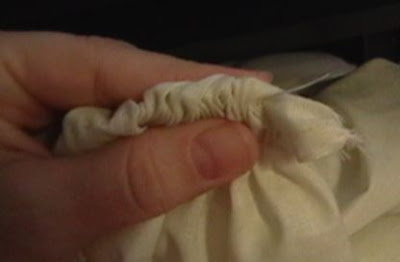I started this project with the drawings I've posted to my SCA German Renaissance Research blog.
I took a piece of fabric about three times my daughter's width. I took this measurement by going from the inside of the ball joint of her shoulder to the other. I simply did a rough guestimate without actually taking measuring tape measurements. After I actually cut the material I found the Grainline article and realized I cut the material the wrong way. (Doesn't that always figure?) Thankfully, it was more than generous in the measurements I took originally even though the skirt itself will be shorter, but it will still be long on her. Cool, huh? I'd only cut the material the one direction, so the other still had the selvedges. Btw, I am just using a plain light-weight cotton, originally about 45" wide. I'll work with better material when I know what I'm doing.
So, I pulled out the stitching I'd originally started... [shown here] This is what I'm considering is how you're supposed to do these stitches. All assumption on my part.

Feb 24, 2008
Then I started with the correct fabric orientation and realized I had another problem...
 It's gathering nicely, so I hope my first assumption wasn't bad, but what in the world do I do with the edge? If I take it from the gathers and try to sew it down, do I hope it works right? It's rather bulky to work with it this way, so somehow I'm assuming this is likely not the right method.
It's gathering nicely, so I hope my first assumption wasn't bad, but what in the world do I do with the edge? If I take it from the gathers and try to sew it down, do I hope it works right? It's rather bulky to work with it this way, so somehow I'm assuming this is likely not the right method.So now I'm trying... duh-duh-duh-da-duh! Doing the hem and gathers at the same time, like in the following:
I pressed the material with my fingers, not quite in thirds and worked on tacking down the lower stitch first. The upper stitch was easier if I didn't have to worry about keeping the material in place while I was stitching, like I had to do with the lower edge.
This is how it looks from the front with some of the edge gathered and some not. When it's not gathered, you can see the hem on the back showing through the material, BUT once it's gathered, it's gone.
Here are the same gathers from the back.

 ... butterfly sleeves and all. I hadn't really intended the sleeves to look like that, but considering she's a 3 year old that will be running around in the summer wearing something along these lines, it should work. She's already worn this a few times, hence a nice grass stain on the hem I need to wash out, but hey, she had fun. :)
... butterfly sleeves and all. I hadn't really intended the sleeves to look like that, but considering she's a 3 year old that will be running around in the summer wearing something along these lines, it should work. She's already worn this a few times, hence a nice grass stain on the hem I need to wash out, but hey, she had fun. :)




